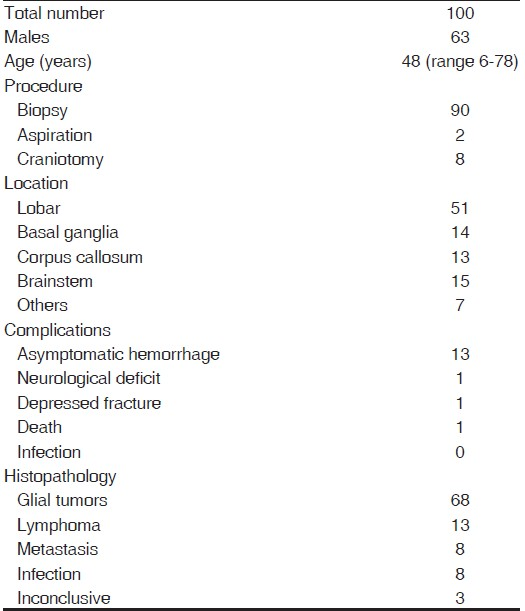Translate this page into:
Stereotactic procedures using the BRA_K (FN) system: An experience with the first 100 cases
This is an open-access article distributed under the terms of the Creative Commons Attribution-Noncommercial-Share Alike 3.0 Unported, which permits unrestricted use, distribution, and reproduction in any medium, provided the original work is properly cited.
This article was originally published by Medknow Publications & Media Pvt Ltd and was migrated to Scientific Scholar after the change of Publisher.
Sir,
The stereotactic technique for intracerebral lesions is widely accepted. Biopsy is the most commonly performed stereotactic surgical procedure. The commonly used frame systems for stereotactic procedures are: Brown-Roberts-Wells (BRW), Cosman-Roberts-Wells (CRW), and Leksell.[12] Stereotactic biopsy (STB) offers a rapid and accurate histological diagnosis for the subsequent management of brain lesions, with minimal morbidity and mortality. Overall, STB provides an accurate diagnosis in 80-99% of the cases.[3] The risk of complications of 1% or less has been reported using current technologies, of which the most significant risk is bleeding.[2] Stereotactic procedures are restricted to large hospitals and institutes, because of the cost of these stereotactic systems. An economical stereotactic system, BRA-K (FN) Virtuoso Universa is available in India. The BRA-K (FN) stereotactic system is similar to the CRW-FN system. The localizer frame of BRA-K (FN) provides flexibility in the positioning of the patient and the gantry. The Leksell localizer makes the system gantry-dependent. The Leksell frame has to be fixed to the CT table, and the alignment of the CT gantry has to be perpendicular to the localizer frame. The drawback of BRA-K (FN) is the need for a separate software to compute the target coordinates. With the Leksell frame, the target coordinates are read off the CT scanner directly. The BRA-K (FN) is available with a phantom base; this feature is lacking in the Leksell system. This allows the surgeon to verify the coordinates before it is used on the patient, thus providing additional safety.[1]
Our study aims to analyze the spectrum of cases that have undergone the stereotactic procedure using the BRA-K (FN) Virtuoso Universa system in a single neurosurgical hospital. The technique of the procedure, morbidity, diagnostic accuracy, and spectrum of diagnosis are analyzed. The results are summarized in Table 1. The procedure has been performed on patients of all age groups. Biopsy material can be obtained from all common locations in the brain, including the skull base, suprasellar, and posterior third ventricular region. Sufficient material has been obtained to get the immunohistochemistry in four cases, revealing diagnosis of glioblastoma in two, lymphoma in one, and adenocarcinoma in one case. The yield, neurological deficits, and mortality are 97, 1, and 1%, respectively; these rates are comparable with literature.[4]

The BRA-K (FN) stereotactic system is safe and accurate. It can be used for diagnosis and treatment. It has a good yield and low morbidity that is comparable to other systems. It is more economical as compared to other systems, and can be acquired by a small hospital or a practicing neurosurgeon.
References
- Image-guided stereotactic instrumentation. In: Ramamurthi R, Sridhar K, Vasudevan MC, eds. Textbook of Operative Neurosurgery. New Delhi: BI Publications; 2005. p. :85-92.
- [Google Scholar]
- An analysis of the respective risks of hematoma formation in 361 consecutive morphological and functional stereotactic procedures. Neurosurgery. 2002;50:48-57.
- [Google Scholar]
- Correlation of diagnostic yield of stereotactic brain biopsy with number of biopsy bits and site of the lesion. Brain Tumor Pathol. 2006;23:71-5.
- [Google Scholar]





